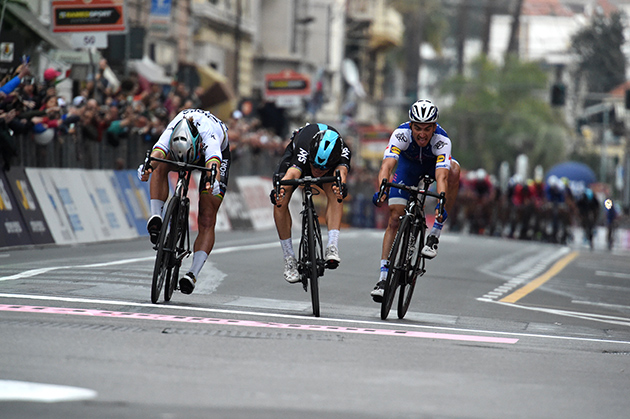Bicycle Racing News and Opinion,
Sunday, March 19, 2017
Back to news and opinion index page for links to archived stories | Commentary | Our YouTube page
2017 Tour de France | 2017 Giro d'Italia
The price of inaction is far greater than the cost of making a mistake. - Meister Eckhart
Upcoming racing:
- March 20 - 26: Volta Ciclista a Catalunya
Latest completed racing:
- March 18: Classic Loire Atlantique
- March 18: Milano-San Remo
- March 17: Handzame Classic
- March 15: Nokere Koerse
- March 8 - 14: Tirreno-Adriatico
- March 5 - 12: Paris-Nice
Here are scenes of the 2011 Gent 6-Day Madison race we filmed. There is nothing like being at a small indoor velodrome filled with Belgian bike racing fans. The excitement is extraordinary.
Peter Sagan's Bora-hansgrohe team reports on the 2017 Milano-San Remo

Having placed in the top ten in four of the last five editions of Milano-Sanremo, the UCI World Champion, Peter Sagan, was looking to become the first man to win the race in the rainbow stripes in more than 30 years. Making an audacious attack on the Poggio, the BORA-hansgrohe rider made the 108th edition of the UCI World Tour’s longest race one to remember, just beaten to the win on the line after an audacious attack on the upper slopes of the Poggio, but taking top spot in the UCI World Tour after a successful start to his season.
The first of cycling’s five Monuments – the hardest, most prestigious and most historic one-day races in the cycling calendar – ‘La Primavera’ is known as the sprinters’ classic. However, this does not mean the going is easy – the distance alone, at 291km, makes this one of the longest one-day races, while the course itself features some testing climbs that come just at the time riders will be feeling the distance in their legs. The most famous is the Poggio – just a few kilometres before the finish. While the average gradient, at just 3.7%, is fairly gentle by professional cycling’s standards, with nearly 300km already raced at the relentless pace only sprinters can muster, this is the point at which the eventual winner has to make sure they’re at the front in order to contest the finale.
In spite of the distance ahead of them, some brave souls made the jump after 10km, quickly building up a sizeable advantage. With a long day still ahead of them, the peloton allowed the break to go out ahead – knowing that the final 30km of the race were where the fireworks were going to happen. With some windy and foggy weather on the roads ahead, the contenders were conserving their energy for the finale, with BORA-hansgrohe taking charge at the front to control the pace to keep Peter Sagan fresh for the finish. The kilometres ticked down and the break fell from more than five minutes to two as the race neared its final 50km.
The Cipressa was where the race came alive – the day’s penultimate climb and where the break was finally caught. No sooner had the escapees been reeled in, when the attacks came as fresher legs took charge, making audacious attempts to break away, only to be pulled back by the sprint teams, who were massing near the front. Knowing the race well, the UCI World Champion kept his head and saved himself for the day’s final climb, the Poggio. Sitting in the middle of the bunch as the road turned upwards, the Slovak rider was well-protected by his teammates – close enough to react to any attacks, but not so far ahead that he was expending energy.
With 6.3km of the race left, Peter attacked with a devastating turn of speed, dropping the peloton and with only a couple of riders able to go with him. Holding off the bunch in a way only he can with immense speed on the descent into Sanremo, it was all down to the three riders on the front as the finish line loomed. Putting everything into his sprint, Peter was just beaten by Sky’s Kwiatkowski, throwing his bike at the line to try and take the few centimetres that would make the difference.

A really close finish after almost 300 kilometers
While he wasn't able to take the win, Peter was pleased with the exciting finale – both for himself and the fans watching the race. “I gave my all today. My team did a great job getting me to the Poggio safely. Luckily we didn’t crash – that was really important, as it was very close at the finish line after I finished my sprint. I think it’s important for the fans to have a spectacle – everyone’s happy. It was instinct to attack on the Poggio – I tried and after I attacked I saw I was alone, and then Kwiatkowski and Alaphilippe came with me. We descended to the finale and made it something really special.”
BORA-hansgrohe Team Coach, Patxi Vila, saw the race unfold exactly as planned, only for Peter just to miss out on the line. "Today's race followed the plan we had. We knew that Peter had to attack on the Poggio because that was the only point where he could drop everybody. From the morning, our objective was to bring him there in the best position possible and the squad did a very good job. He went on fire on the Poggio and the goal was to go solo, but Kwiatkowski and Alaphilippe went after him. We had expected the last two guys to go with him would be them, and it proved to be the case. Peter then did an incredible job in the descent and then the flat part but, unfortunately, he was beaten on the line by Kwiatkowski. It hurts when you lose by a couple of centimetres but that's how it is. It's part of the game. Still, Peter and the whole team deserve congratulations for their big effort."
Lotto-Soudal's Milano-San Remo report
The team sent me this:
Today, Milan-Sanremo was organized for the 108th time. After 291 kilometres eternal fame was waiting for the winner on the Via Roma.
Almost immediately after the start the traditional early break was already established. It consisted of ten riders. The peloton didn’t give them more than four and a half minutes lead. On the top of the Passo del Turchino 2’15” advantage was left. As it was still about 150 kilometres to go till the finish and the peloton didn’t want to catch the break too early, the gap got bigger again. This time over five minutes. The route ran along the Ligurian coast towards the Capi, where the front group had only one and a half minutes lead left.
In the run-up to the Cipressa Lotto Soudal moved up to the front of the peloton. Marcel Sieberg raised the pace before the bottom of the climb. On the Cipressa the last escapees got reeled in. Tim Wellens joined an attack. When the peloton was about to close the gap, the Belgian accelerated again. Unfortunately, the bunch came back again. Together with Tony Gallopin Tim was positioned at the front of the bunch when starting the descent of the Cipressa. In that descent Tony Gallopin decided to take his chance and he attacked. He was accompanied by some riders, but BORA - hansgrohe – the team of Peter Sagan – made sure they got caught. It lasted until one kilometre from the top of the Poggio before anyone attacked again. It was world champion Peter Sagan who took the initiative. Only Julian Alaphilippe and Michal Kwiatkowski could follow him. The peloton wouldn’t catch them anymore. In a thrilling sprint Kwiatkowski succeeded in beating Sagan. Tim Wellens was the first Lotto Soudal rider to cross the finish, he was eighteenth.
Tim Wellens: “We knew before the start that if we wanted to have a chance to win, we should not race passively. We tried to start up the race on the Cipressa. I was the first of our team to attack. I hoped to get away with a group, but the teams of the sprinters kept the pace too high. In the descent Tony attacked, unfortunately with no success either. Also on the Poggio it was impossible to ride away, except for the trio that did: they are on a different level. I could never have followed them, that’s why I decided to anticipate. From the past weeks in Italy I will remember my great début at Strade Bianche where I got third. In Tirreno-Adriatico it went less smoothly, but today I had good legs. Unfortunately the race developments made it impossible to benefit from it. Who knows, I might be able to follow the best in one of the next editions.”
Marc Sergeant, sports manager Lotto Soudal: “The riders executed our plan. That was not sufficient to set a good result. Peter Sagan was riding very impressive once again. He took Alaphilippe and Kwiatkowski on his wheel for most of the time, because he knew he would not be able to win the sprint of the reduced peloton. All three have performed so strong the past few weeks. They are the best riders of the moment.”
“On the Cipressa the pace was raised, which made it impossible for riders to stay ahead. Tim and Tony did what they had to do. Milan-Sanremo is probably the most difficult of the Classics to win. Tim is our first rider in the ranking. He got eighteenth. That’s not a success of course, but when you take a look at the results, you see that it are all sprinters behind the top three. Now it’s time for the cobblestone Classics for which we have a strong team. We are looking forward to what is coming.”
Giro d’Italia in Bormio: Legendary climbs for the 100th edition
This came from the Bormio press office:
Our friends at CycleItalia will be headed to the big stuff this year. Here's a link to see how you can join them in the Dolomites. Larry notes: your readers should know WE (unlike most of our competitors) take you up the Stelcio's traditional direction with the famous 48 numbered switchbacks
And here's the story of my own ride up the Stelvio.
Bormio, March 16th, 2017 – The Giro d’Italia is the second most important multi-stage bicycle race in the world after the Tour de France. For the 100th time, road cycling pros will be racing through Italy. 3,572 kilometers / 2,219 miles and some very demanding mountain passes such as Stelvio, Mortirolo and Umbrail– will be on the agenda from May 5-28.
The 2017 Giro d’Italia will be returning to the Stelvio and to the Mortirolo. The contestants will however be heading to the Umbrail Pass for the first time ever in the history of the prestigious race. The Stelvio Pass is on the bucket list of road cyclists from all over the world and poses to be a great challenge for every professional athlete: the route from Bormio winds up in 40 hairpin turns which are spread out over a distance of 21 kilometers / 13 miles and a difference in level of 1,533 meters / 5,029 feet. The top of the “Queen of Alpine roads” reaches 2,758 meters / 9,048 feet above sea level. Climbing the Mortirolo with a vertical drop of 800 meters / 2,624 feet and a length of around 10 kilometers / 6.2 miles is not to be underestimated, either. The climb from Monno with an average gradient of 7.5% and a maximum of more than 10% is rather unusual, but quite demanding, especially in the last part with the characteristic bends that lead up to the pass.

The incredible Stelvio Pass
“The queen stage of the 100th Giro will be of utmost importance for the race”, says Luca Guercilena, General Manager of Trek-Segafredo. “With 227 kilometers / 141 miles, it is not only a long stage, the mythical Mortirolo and Stelvio will take their toll as well. However, the stage finishes with a long descent so this might benefit those who have perfected this technique of riding.”
Stage 16 will lead from Rovetta to Bormio on May 23; it is the longest stage of this year’s Giro and the Mortirolo (1,854 meters / 6,082 feet above sea level), Stelvio and Umbrail (2,502 meters / 8,208 feet above sea level) will push the cycling pros to their limits. From Monno, the route leads the cycling elite via the Mortirolo to Bormio, from where they will be fighting 40 hairpin bends on 21 kilometers / 13 miles on their way to the summit. Once the fastest has reached the top, he will earn himself the mountain bonus „Cima Coppi“ which is awarded to the first rider who reaches the Giro's highest summit. On the way down to Prato and Glorenza, an altitude difference of 1,900 meters / 6,234 feet and 48 hairpin bends await the cycling pros. After having crossed the Swiss border, the athletes will climb up the Umbrail pass leading back to Italy for the first time in the history of the Giro. They will get back to the Stelvio Pass road just three kilometers from the summit and then descend to Bormio.
Back on the south ramp, it is downhill to the finish line in Bormio. Bauke Mollema (NED), team member of UCI WorldTeam Trek-Segafredo: “This stage will be after the last restday, so everybody will be refreshed and ready to go. And for this long and hard stage you also need it! It will be a crucial stage of this Giro including the Mortirolo and two times the Stelvio. We will not climb the Mortirolo from the steepest side, but it is still a very long climb. The length is also what makes the Stelvio a difficult climb. We have to overcome an altitude of 2,500 meters / 8,202 feet. In my opinion, it will be one of the hardest stages of the Giro.”
Fans who have always wanted to ride side by side with a pro can look forward to a special highlight: On May 22, ambitious cyclists will have the opportunity to climb the steep, meandering Stelvio in the company of former road cycling pro and winner of the Giro d’Italia 2006 and 2010 Ivan Basso (ITA). Since autumn 2016, Ivan Basso has been active in a consulting role for the UCI WorldTeam Trek-Segafredo. In this function, he will primarily focus on the development of young riders.
Back to news and opinion index page for links to archived stories | Commentary









